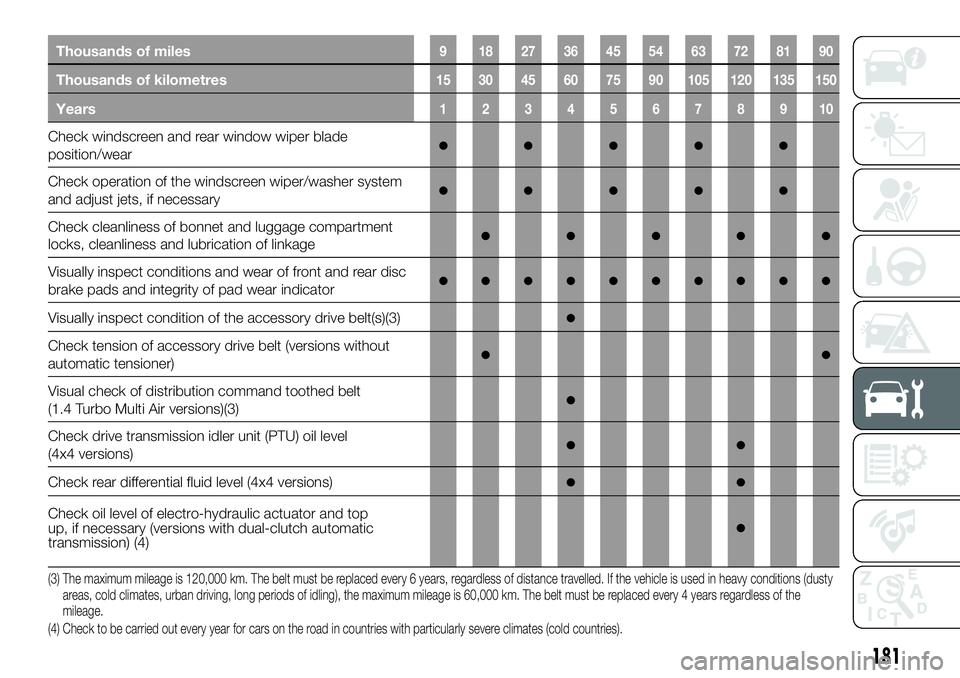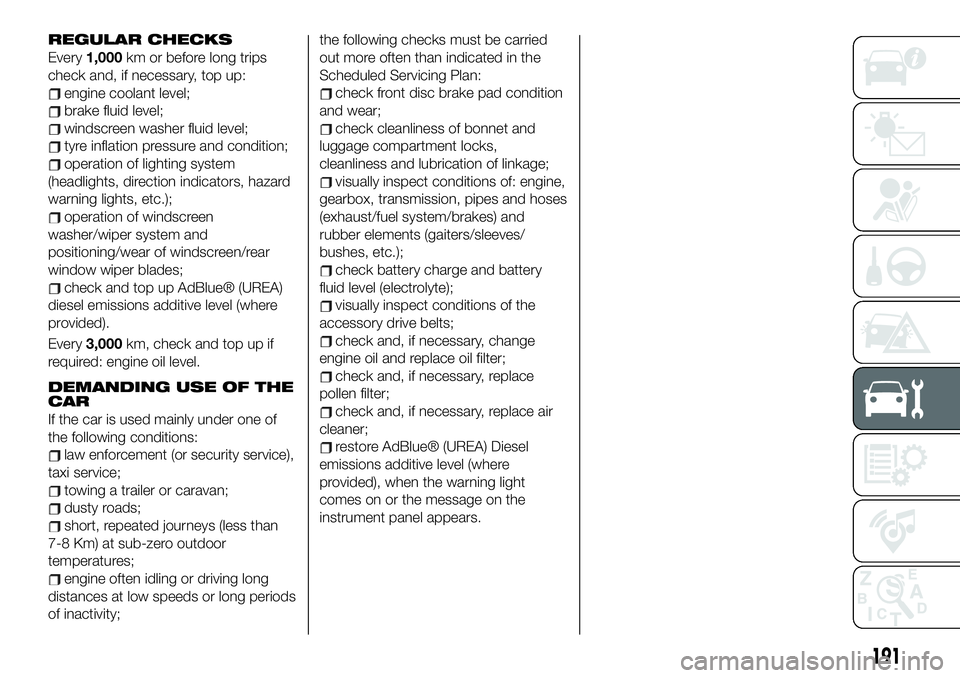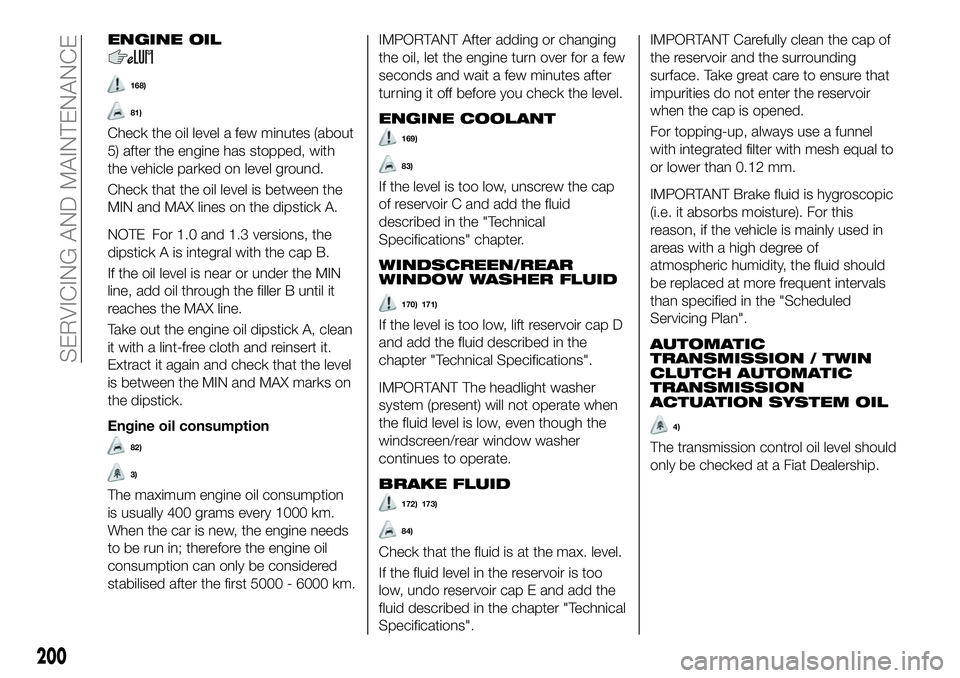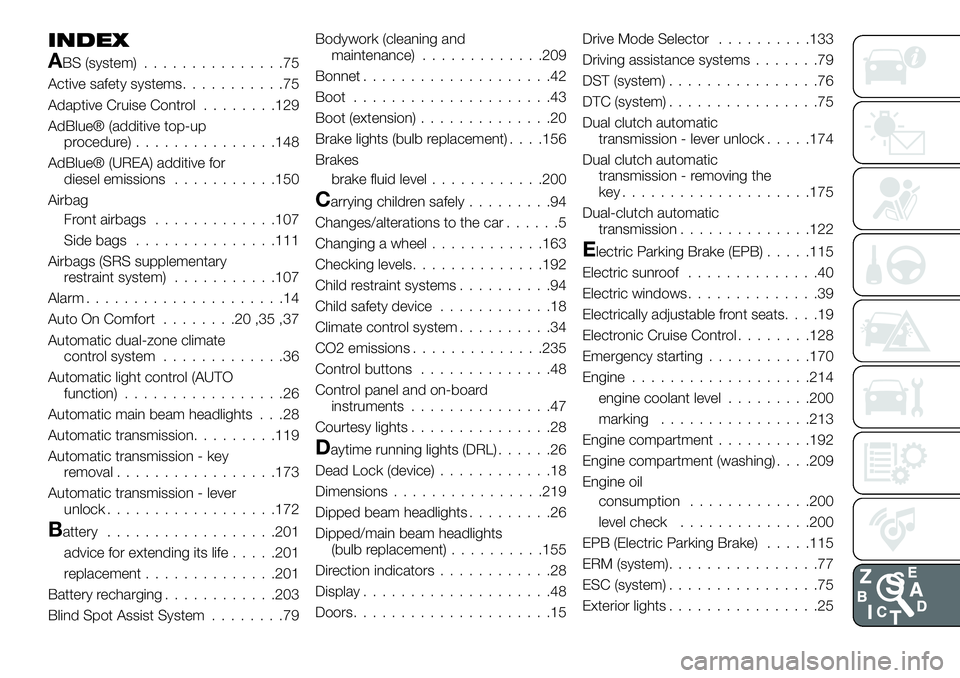check transmission fluid FIAT 500X 2019 Owner handbook (in English)
[x] Cancel search | Manufacturer: FIAT, Model Year: 2019, Model line: 500X, Model: FIAT 500X 2019Pages: 284, PDF Size: 8.33 MB
Page 183 of 284

Thousands of miles9 182736455463728190
Thousands of kilometres15 30 45 60 75 90 105 120 135 150
Years12345678910
Check windscreen and rear window wiper blade
position/wear●●●●●
Check operation of the windscreen wiper/washer system
and adjust jets, if necessary●●●●●
Check cleanliness of bonnet and luggage compartment
locks, cleanliness and lubrication of linkage●●●●●
Visually inspect conditions and wear of front and rear disc
brake pads and integrity of pad wear indicator●●●●●●●●●●
Visually inspect condition of the accessory drive belt(s)(3)●
Check tension of accessory drive belt (versions without
automatic tensioner)●●
Visual check of distribution command toothed belt
(1.4 Turbo Multi Air versions)(3)●
Check drive transmission idler unit (PTU) oil level
(4x4 versions)●●
Check rear differential fluid level (4x4 versions)●●
●
(3) The maximum mileage is 120,000 km. The belt must be replaced every 6 years, regardless of distance travelled. If the vehicle is used in heavy conditions (dusty
areas, cold climates, urban driving, long periods of idling), the maximum mileage is 60,000 km. The belt must be replaced every 4 years regardless of the
mileage.
(4) Check to be carried out every year for cars on the road in countries with particularly severe climates (cold countries).
181
Check oil level of electro-hydraulic actuator and top
up, if necessary (versions with dual-clutch automatic
transmission) (4)
Page 191 of 284

Thousands of miles12 24 36 48 60 72 84 96 108 120
Thousands of kilometres20 40 60 80 100 120 140 160 180 200
Years12345678910
Check oil level of electro-hydraulic actuator and top up, if
necessary (1.6 Multijet versions with dual-clutch automatic
transmission)(5)
●
Check rear differential fluid level (2.0 Multijet 4x4 versions)●●
Change engine oil and replace oil filter(6)
Replace accessory drive belt/s(4)
Replace toothed timing drive belt (excluding 1.3 Multijet
16V versions)(4)
Replace fuel filter cartridge(7)
●●●
Replace air cleaner cartridge(8)●●●●●
Change the brake fluid(9)
(5) Check to be carried out every year for cars on the road in countries with particularly severe climates (cold countries).
(6) The actual interval for changing engine oil and replacing the engine oil filter depends on the vehicle usage conditions and is signalled by the warning light or
message in the instrument panel. In any case, it must never exceed 2 years. Where the car is used mostly in urban settings you need to replace the engine oil
filter every year. (4) The maximum mileage is 120,000 km. The belt must be replaced every 6 years, regardless of distance travelled. If the vehicle is used in heavy conditions (dusty
areas, cold climates, urban driving, long periods of idling), the maximum mileage is 60,000 km. The belt must be replaced every 4 years regardless of the
mileage.
(7) If the vehicle runs on fuel with quality below the relevant European specification, this filter must be replaced every 20,000 km
(8) If the vehicle is used in dusty areas, this cleaner must be replaced every 20,000 km.
(9) The brake fluid replacement has to be done every two years, irrespective of the mileage.
189
Page 193 of 284

REGULAR CHECKS
Every1,000km or before long trips
check and, if necessary, top up:
engine coolant level;
brake fluid level;
windscreen washer fluid level;
tyre inflation pressure and condition;
operation of lighting system
(headlights, direction indicators, hazard
warning lights, etc.);
operation of windscreen
washer/wiper system and
positioning/wear of windscreen/rear
window wiper blades;
check and top up AdBlue® (UREA)
diesel emissions additive level (where
provided).
Every3,000km, check and top up if
required: engine oil level.
DEMANDING USE OF THE
CAR
If the car is used mainly under one of
the following conditions:
law enforcement (or security service),
taxi service;
towing a trailer or caravan;
dusty roads;
short, repeated journeys (less than
7-8 Km) at sub-zero outdoor
temperatures;
engine often idling or driving long
distances at low speeds or long periods
of inactivity;the following checks must be carried
out more often than indicated in the
Scheduled Servicing Plan:
check front disc brake pad condition
and wear;
check cleanliness of bonnet and
luggage compartment locks,
cleanliness and lubrication of linkage;
visually inspect conditions of: engine,
gearbox, transmission, pipes and hoses
(exhaust/fuel system/brakes) and
rubber elements (gaiters/sleeves/
bushes, etc.);
check battery charge and battery
fluid level (electrolyte);
visually inspect conditions of the
accessory drive belts;
check and, if necessary, change
engine oil and replace oil filter;
check and, if necessary, replace
pollen filter;
check and, if necessary, replace air
cleaner;
restore AdBlue® (UREA) Diesel
emissions additive level (where
provided), when the warning light
comes on or the message on the
instrument panel appears.
191
Page 202 of 284

ENGINE OIL
168)
81)
Check the oil level a few minutes (about
5) after the engine has stopped, with
the vehicle parked on level ground.
Check that the oil level is between the
MIN and MAX lines on the dipstick A.
NOTE For 1.0 and 1.3 versions, the
dipstick A is integral with the cap B.
If the oil level is near or under the MIN
line, add oil through the filler B until it
reaches the MAX line.
Take out the engine oil dipstick A, clean
it with a lint-free cloth and reinsert it.
Extract it again and check that the level
is between the MIN and MAX marks on
the dipstick.
Engine oil consumption
82)
3)
The maximum engine oil consumption
is usually 400 grams every 1000 km.
When the car is new, the engine needs
to be run in; therefore the engine oil
consumption can only be considered
stabilised after the first 5000 - 6000 km.
IMPORTANT After adding or changing
the oil, let the engine turn over for a few
seconds and wait a few minutes after
turning it off before you check the level.
ENGINE COOLANT
169)
83)
If the level is too low, unscrew the cap
of reservoir C and add the fluid
described in the "Technical
Specifications" chapter.
WINDSCREEN/REAR
WINDOW WASHER FLUID
170) 171)
If the level is too low, lift reservoir cap D
and add the fluid described in the
chapter "Technical Specifications".
IMPORTANT The headlight washer
system (present) will not operate when
the fluid level is low, even though the
windscreen/rear window washer
continues to operate.
BRAKE FLUID
172) 173)
84)
Check that the fluid is at the max. level.
If the fluid level in the reservoir is too
low, undo reservoir cap E and add the
fluid described in the chapter "Technical
Specifications".
IMPORTANT Carefully clean the cap of
the reservoir and the surrounding
surface. Take great care to ensure that
impurities do not enter the reservoir
when the cap is opened.
For topping-up, always use a funnel
with integrated filter with mesh equal to
or lower than 0.12 mm.
IMPORTANT Brake fluid is hygroscopic
(i.e. it absorbs moisture). For this
reason, if the vehicle is mainly used in
areas with a high degree of
atmospheric humidity, the fluid should
be replaced at more frequent intervals
than specified in the "Scheduled
Servicing Plan".
AUTOMATIC
TRANSMISSION / TWIN
CLUTCH AUTOMATIC
TRANSMISSION
ACTUATION SYSTEM OIL
4)
The transmission control oil level should
only be checked at a Fiat Dealership.
200
SERVICING AND MAINTENANCE
Page 279 of 284

INDEX
ABS (system)...............75
Active safety systems...........75
Adaptive Cruise Control........129
AdBlue® (additive top-up
procedure)...............148
AdBlue® (UREA) additive for
diesel emissions...........150
Airbag
Front airbags.............107
Side bags...............111
Airbags (SRS supplementary
restraint system)...........107
Alarm.....................14
Auto On Comfort........20,35,37
Automatic dual-zone climate
control system.............36
Automatic light control (AUTO
function).................26
Automatic main beam headlights . . .28
Automatic transmission.........119
Automatic transmission - key
removal.................173
Automatic transmission - lever
unlock..................172
Battery..................201
advice for extending its life.....201
replacement..............201
Battery recharging............203
Blind Spot Assist System........79Bodywork (cleaning and
maintenance).............209
Bonnet....................42
Boot.....................43
Boot (extension)..............20
Brake lights (bulb replacement). . . .156
Brakes
brake fluid level............200
Carrying children safely.........94
Changes/alterations to the car......5
Changing a wheel............163
Checking levels..............192
Child restraint systems..........94
Child safety device............18
Climate control system..........34
CO2 emissions..............235
Control buttons..............48
Control panel and on-board
instruments...............47
Courtesy lights...............28
Daytime running lights (DRL)......26
Dead Lock (device)............18
Dimensions................219
Dipped beam headlights.........26
Dipped/main beam headlights
(bulb replacement)..........155
Direction indicators............28
Display....................48
Doors.....................15Drive Mode Selector..........133
Driving assistance systems.......79
DST (system)................76
DTC (system)................75
Dual clutch automatic
transmission - lever unlock.....174
Dual clutch automatic
transmission - removing the
key....................175
Dual-clutch automatic
transmission..............122
Electric Parking Brake (EPB).....115
Electric sunroof..............40
Electric windows..............39
Electrically adjustable front seats....19
Electronic Cruise Control........128
Emergency starting...........170
Engine...................214
engine coolant level.........200
marking................213
Engine compartment..........192
Engine compartment (washing). . . .209
Engine oil
consumption.............200
level check..............200
EPB (Electric Parking Brake).....115
ERM (system)................77
ESC (system)................75
Exterior lights................25